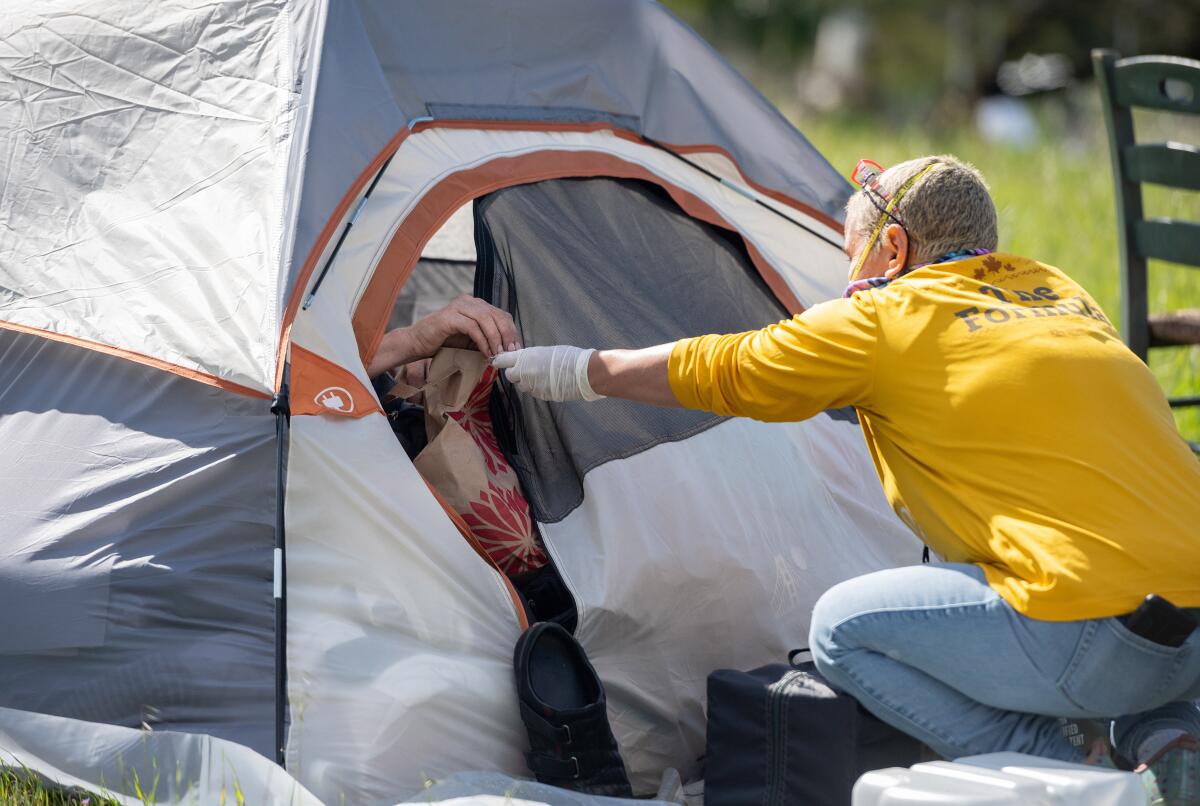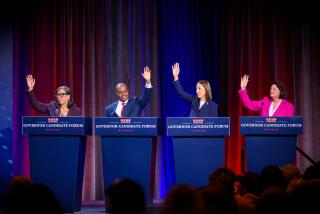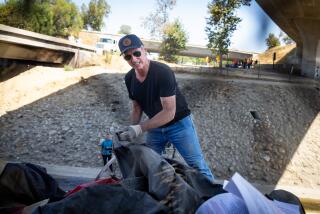Editorial: On homelessness, recall candidates offer hot air, not real solutions

Encampments are everywhere in a state that, at last count, had 161,000 homeless people. A humanitarian crisis that has been building over many years has metastasized in recent years, frustrating residents, business owners and all Californians of good conscience.
So it makes sense that the recall candidates seeking to replace Gov. Gavin Newsom have questioned his record on the issue. However, none have anything to offer beyond sweeping but ill-conceived plans that would swoop up homeless people into shelters and force them to confront their mental illness or substance abuse issues.
Why is that so wrong? Because forcing people into any place they donât want to go, or any place without a certain amount of privacy and autonomy, is ineffective. People wonât leave pets, partners, or bags of their belongings to go to a group shelter with curfews and strict rules (and some shelters have had COVID outbreaks).
And government canât compel people to enter shelters. It can merely force them off sidewalks.
Here is what the leading candidates, most of them Republicans, propose to do.
San Diego businessman John Cox would force people to accept mental health or substance abuse treatment as a condition for placement in any kind of government-financed shelter or housing. This unwisely subverts the long-accepted, successful âHousing Firstâ model, which is based on the philosophy that people need the stability of a place to live before they can find a job or address demons like mental illness and dependency on drugs or alcohol.
Housing First doesnât work for every homeless person, but it has worked for tens of thousands in Los Angeles County who now live in permanent supportive housing which comes with services they can accept (or not) on their own timetables.
L.A. Homeless Services Authority officials say that 90% of people who go into permanent supportive housing in L.A. County are still housed a year later.
The ultra-conservative radio talk show host and lawyer Larry Elder also does not believe in the Housing First approach, saying that housing doesnât help people until they can deal with the underlying reasons for their homelessness â which he believes are drug use and mental illness. He would enlist the help of churches in reaching out to homeless people.
Kevin Faulconer, former mayor of San Diego, says there should be a right to shelter across the state and an obligation to take it â or face being rousted off a sidewalk by police. But all that will do is force municipalities to divert tens of millions of dollars from creating permanent housing to building shelters. Yes, some cities need more shelter, but what is more desperately needed is permanent housing. Fortunately, Faulconer said he would continue to fund state efforts to create more housing for homeless people.
Kevin Paffrath, a young social media influencer and one of the few Democrats on the ballot, would create 80 convention center-style shelters across the state to house about 2,000 people each. But transitioning out of homelessness is not like recovering from a hurricane, where you sit in a convention center shelter and wait for insurance adjusters to help get you back into housing. To Paffrathâs credit, he doesnât buy into the trope that homelessness is the result of mental illness or addiction. He says itâs the result of evictions and lack of jobs and opportunities.
Assemblyman Kevin Kiley also believes in building more shelters. While he says mental health and substance abuse problems account for a âlarge shareâ of the problems that led people to homelessness, he acknowledges that financial troubles also contribute.
Based on demographic surveys during the 2020 homeless count, officials in L.A. County estimate that about 25% of homeless people have a serious mental illness and 27% have a substance abuse problem. (41% have one or both.) But whether people need services or not, trying to force them to accept treatment or a shelter bed doesnât work.
And no governor can simply declare that anti-camping laws across the state must be enforced against anyone who refuses to take a shelter bed. Thatâs a tough-talk soundbite but in fact, enforcement of laws like that is carried out at a local level.
What works is housing. Even acutely troubled homeless people can be housed. A study by researchers at University of California, San Francisco, provided permanent supportive housing in Santa Clara County to 169 homeless people who were seen frequently at emergency rooms for psychiatric care or were jailed repeatedly. All were offered intensive services which they could take or not. âWe intentionally chose the most complicated people,â said study author Margot Kushel, a professor of medicine and director of the UCSF Benioff Homelessness and Housing Initiative. Researchers found that the overwhelming majority have stayed housed for several years. âThere is no medicine as powerful as housing,â she says.
All the candidates say they support creation of more housing and reform of the California Environmental Quality Act â which is sometimes used by NIMBYs to quash low-income or homeless housing projects â but none of them has a clear plan for doing either. Nor did they say they were willing to support two controversial bills in the state legislature that would make it easier to build more densely in single family neighborhoods.
By and large, people in California have become homeless because so little affordable housing is available. Thatâs a crisis that developed over the decades as elected state and city officials â pressured by NIMBY homeowners â fought density and did nothing to make it easier or affordable to build in this state. None of these candidates has offered clear solutions on how to change that â particularly because what would be required (rezoning, greater density, higher property taxes) is so politically volatile.
Gov. Newsom has directed billions toward the acquisition of hotels, motels and apartment buildings to turn into housing for homeless people. He isnât perfect, but at least heâs looking for creative ways to increase housing supply, not shelters.
More to Read
A cure for the common opinion
Get thought-provoking perspectives with our weekly newsletter.
You may occasionally receive promotional content from the Los Angeles Times.










